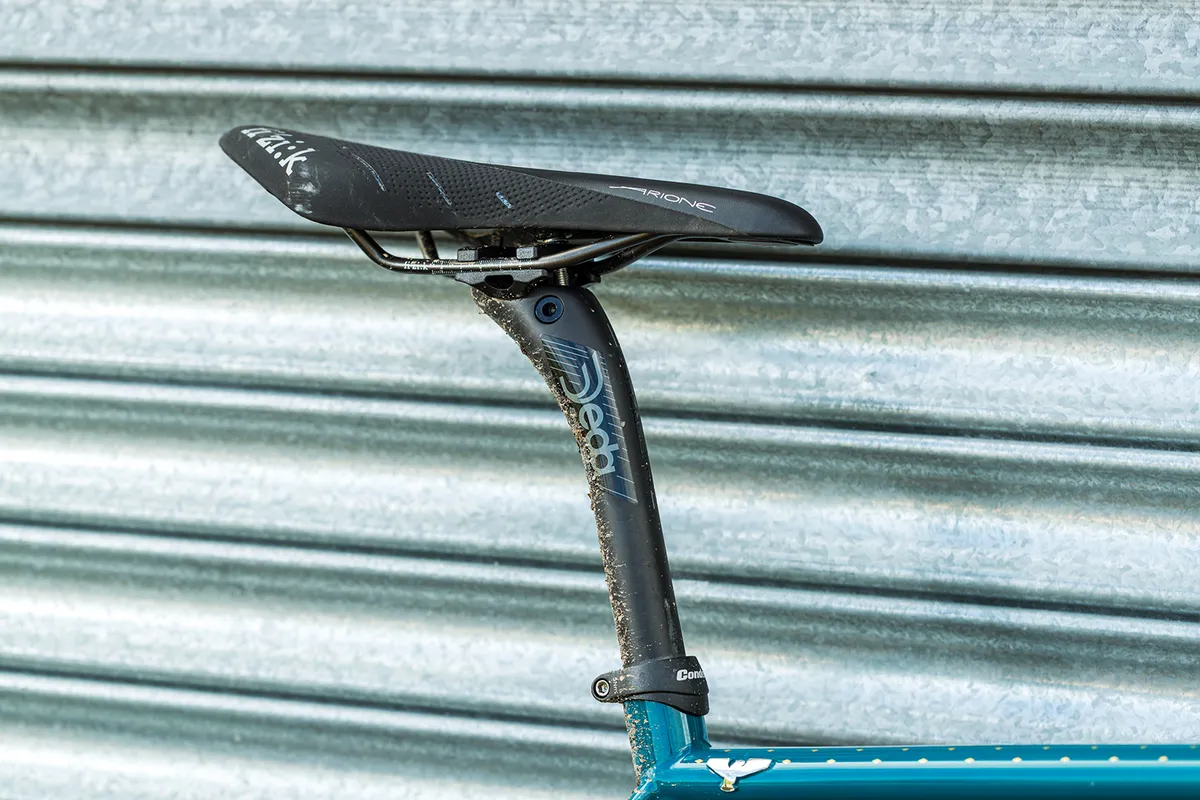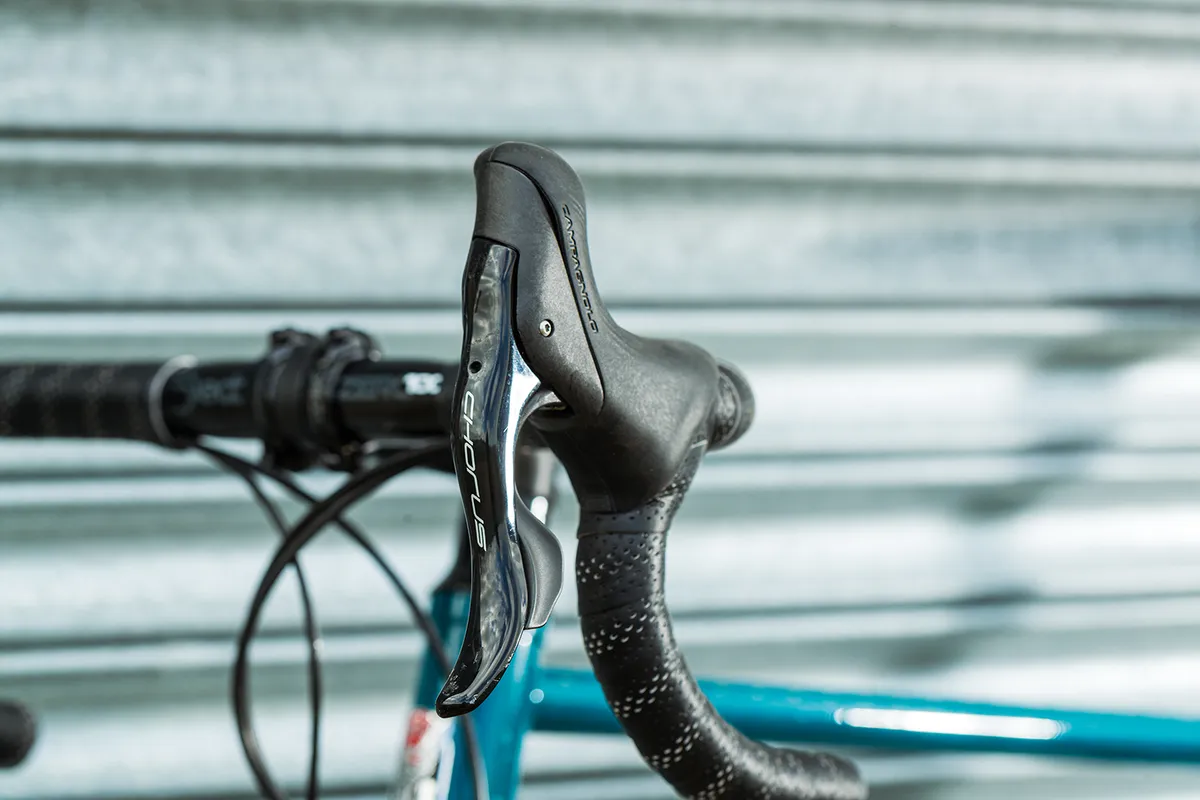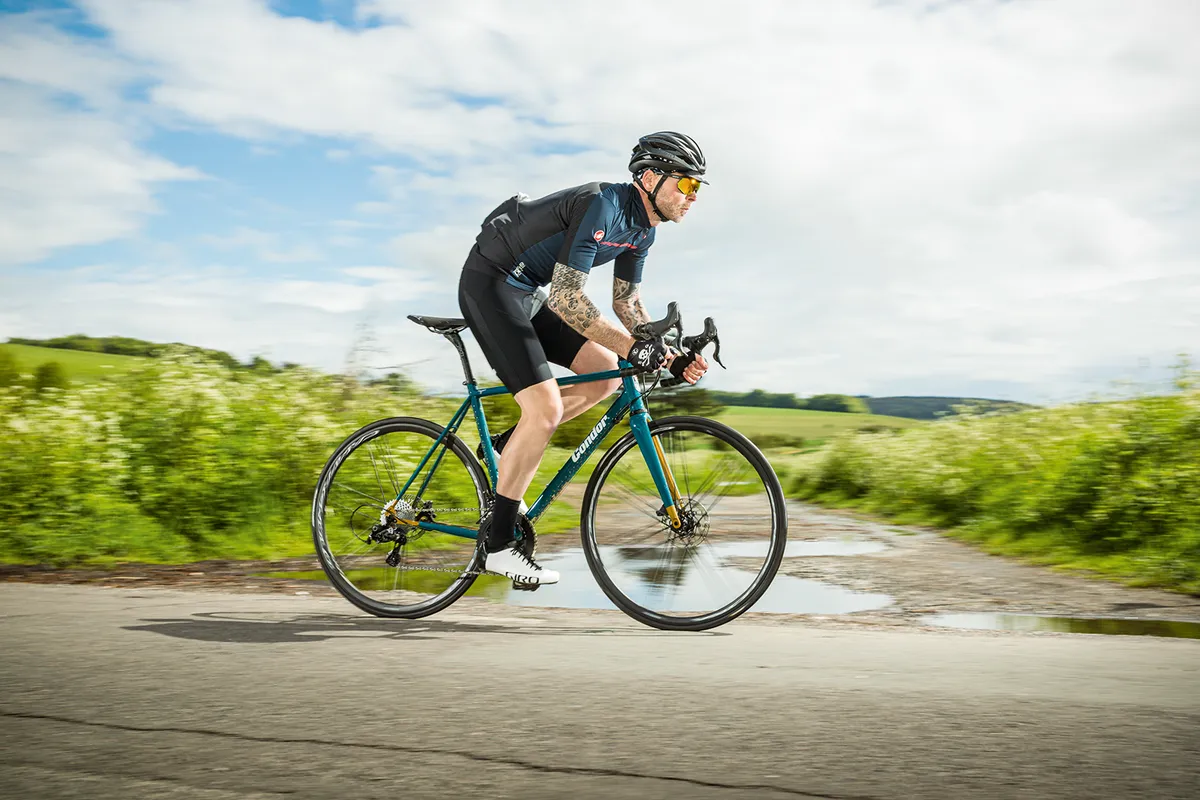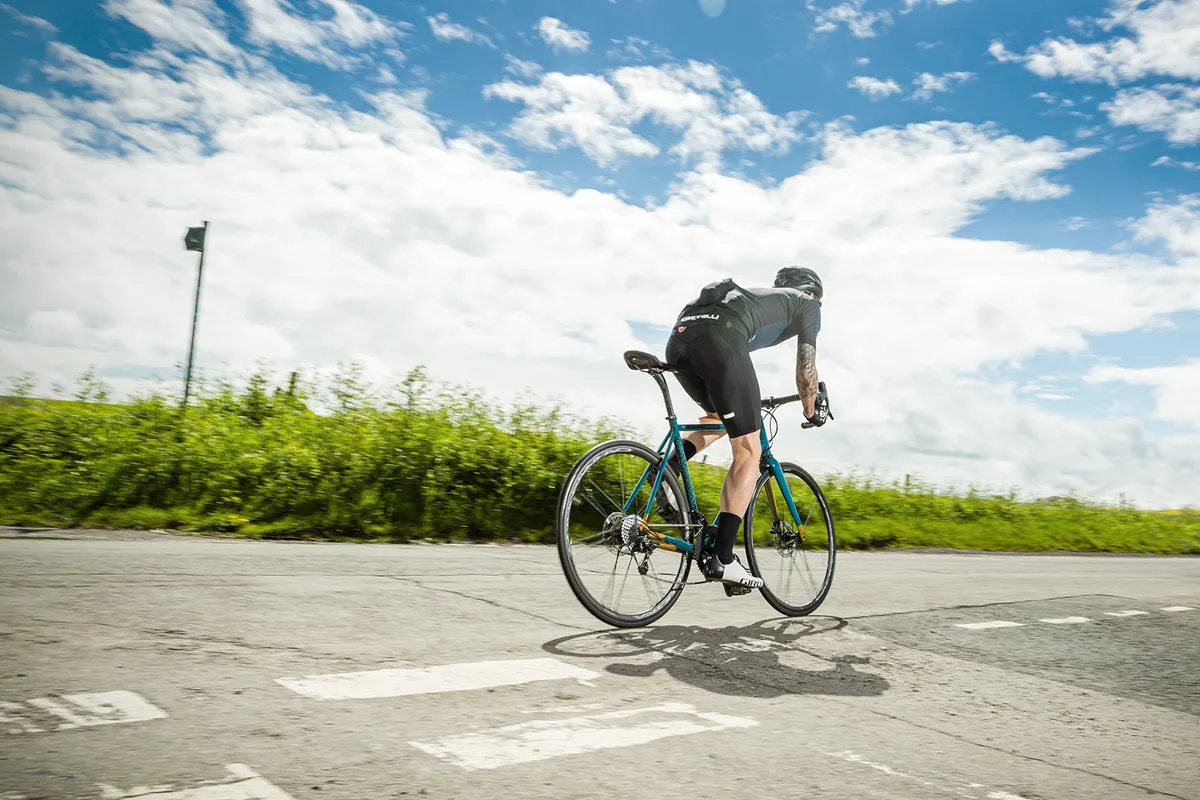Originally designed as a rim-brake bike (still available) for the Rapha Condor pro team back in 2012, the Super Acciaio Disc is the brand’s flagship, steel, disc-brake bike. A fully custom stainless steel version is also available.
The Super Acciaio looks absolutely fabulous in the flesh. The paint is refreshingly jazzy, matching a rich azure with gold highlights. A black version of the bike is also available but you’d be doing yourself a disservice.
I count myself among the many who have fallen for the clean lines of any classic double steel frameset and the Super Acciaio is no exception.
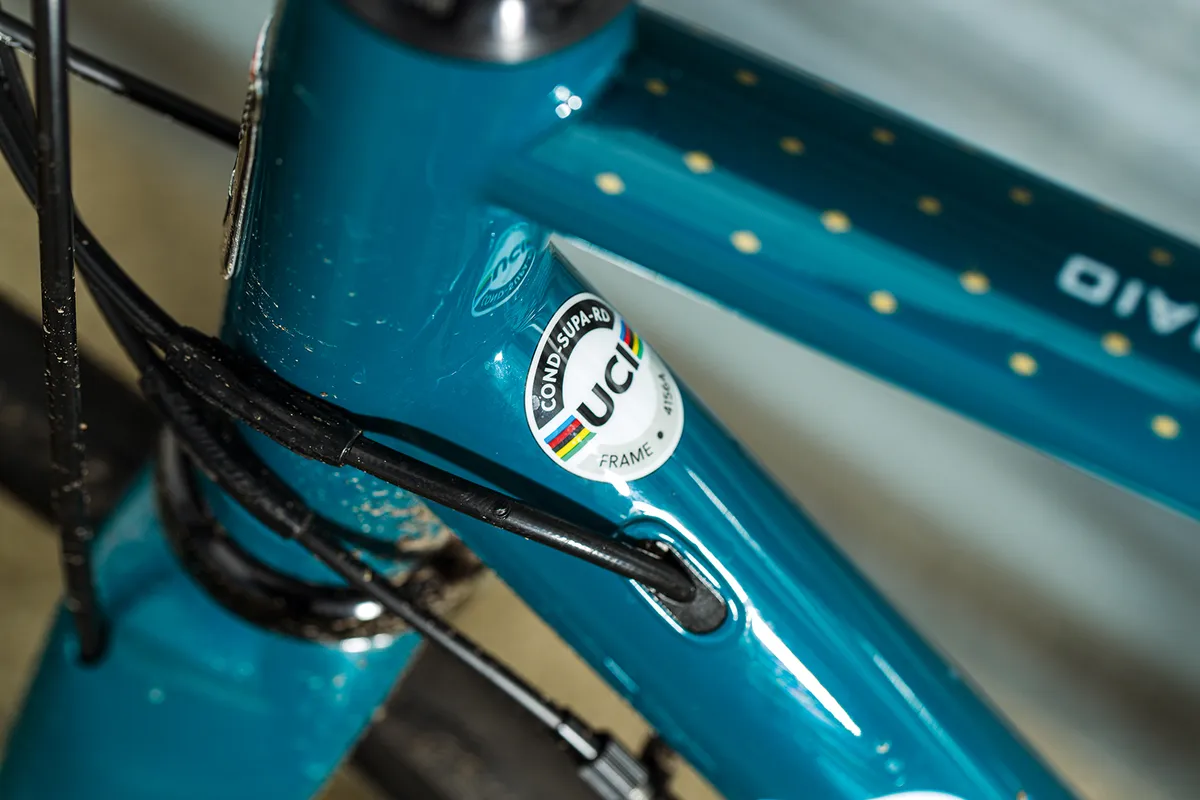
The Columbus Spirit HSS tubeset is custom-formed to Condor’s specifications. This includes the ovalised top tube and square-profiled down tube.
These shapes aren’t quite as wildly boxy as those seen on something like the Cinelli Vigorelli, which could do a pretty good job passing as an aluminium frameset.
However, if you subscribe to the belief that a bicycle can impart feeling, the Super Acciaio undoubtedly casts a ‘purposeful’ silhouette when compared to round-tubed steel bikes.
Condor Super Acciaio Disc frameset
The overall ride quality of the bike matches its looks and is best described as ‘lively, comfortable and responsive’. The frameset provides a perfectly stiff platform for climbing, though it’s no immovable I-beam – it’s possible to elicit flex if you give it some welly – but it’s no overcooked linguine either.
When descending fast, the notably chunky front end doesn’t flutter as can sometimes be seen on more svelte steel bikes. This makes late line changes and heavy braking a less nerve-wracking affair.
Something like my All-City Mr Pink, which uses a very comfortable all-steel fork with a straight steerer, feels great when mashing along on rough roads, but isn’t nearly as confidence-inspiring as a carbon fork and tapered steerer in a hard stop. This is the mark of a good steel bike, offering a pleasingly ‘damped’ ride quality on rough surfaces without feeling woolly or vague.
It’s not all rosy with the frameset, though. The eagle-eyed will note images of the complete Super Acciaio on the Condor website show a different dropout design compared to the bike as tested here.
My production bike uses an extended plate on both the drive- and non-driveside. This switch was made to “visually balance the driveside” and reduce weight, says Condor.
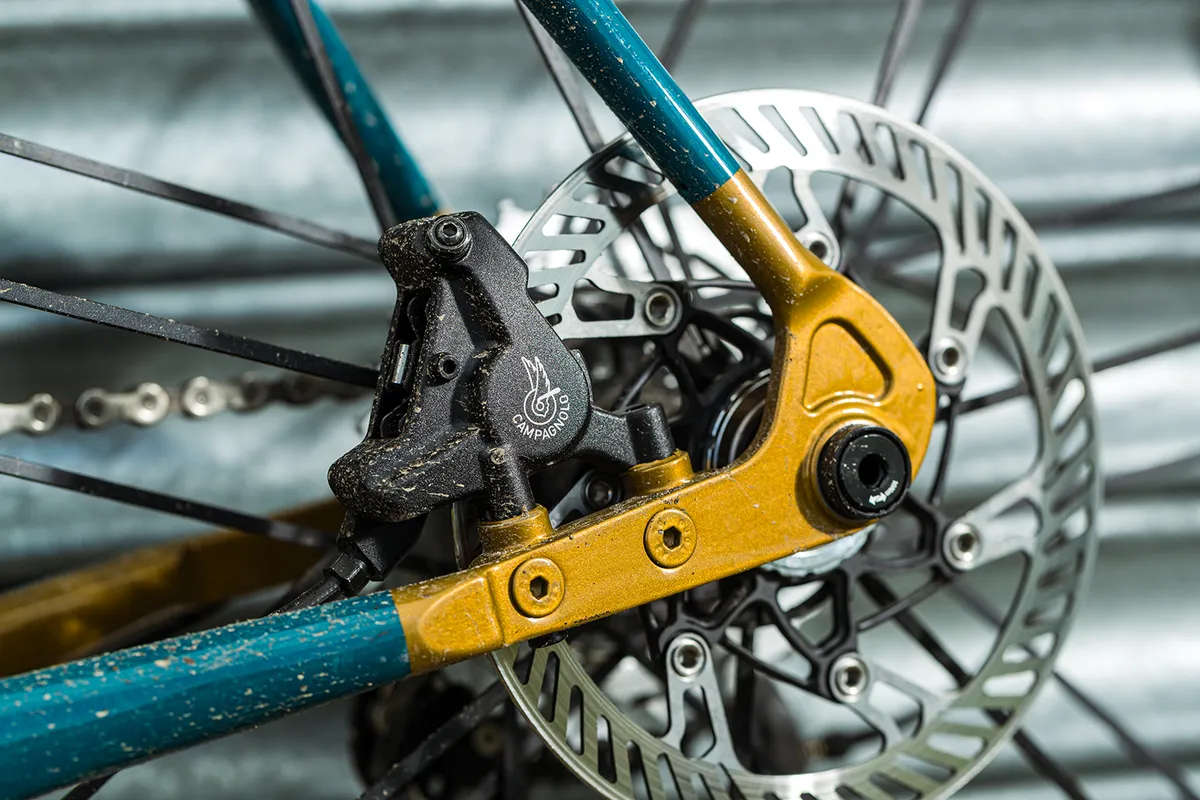
This design means that, rather than immediately sweeping inward from the dropout and reducing the overall width, the rearmost portion of the chainstay is fairly broad, measuring approximately 160mm wide at the front of the dropout plate.
To put this into context, the Fairlight Strael – a similar steel bike I also have in for testing – measures roughly 145mm wide at the same point (circa 31cm from the centre of the bottom bracket along the chainstay).
A Genesis Croix de Fer measures roughly 140mm wide. With a shoe-size of 42.5 (EU), I occasionally scuffed the chainstay when vigorously pedalling out of the saddle. During less dynamic pedalling, I didn’t experience any such issues.
If you have a heels-in pedalling style or large feet, or run a crankset with a very narrow Q-factor, you could have issues with clearance. I would recommend a test ride, if possible.
Potential fit issues aside, the dropouts also look a bit ‘industrial’ – made from relatively thick steel plates, these contrast quite jarringly with the otherwise handsome classic lines of the frameset.
In its favour, if there’s a Condor retailer near you, you can also get a free bike fit as part of the custom-build process.
Condor Super Acciaio Disc geometry
| | 46 | 49 | 52 | 55 | 58 | 61 |
|---|---|---|---|---|---|---|
| Seat angle (degrees) | 75 | 74 | 74 | 73.5 | 73 | 72.5 |
| Head angle (degrees) | 71 | 71.5 | 72 | 73.5 | 74 | 74 |
| Chainstay (cm) | 40.5 | 40.5 | 40.5 | 40.5 | 40.8 | 41 |
| Seat tube (cm) | 46 | 49 | 52 | 55 | 58 | 61 |
| Top tube (cm) | 51.3 | 51.8 | 53.7 | 55.5 | 57 | 58 |
| Head tube (cm) | 11 | 12 | 13.5 | 16.5 | 19.5 | 22.2 |
| Fork offset (cm) | 4.3 | 4.3 | 4.3 | 4.3 | 4.3 | 4.3 |
| Bottom bracket height (cm) | 26.5 | 26.5 | 26.5 | 26.5 | 26.5 | 26.5 |
| Stack (cm) | 50.6 | 51.7 | 53.3 | 56.6 | 59.7 | 62.3 |
| Reach (cm) | 37.7 | 37 | 38.4 | 38.7 | 38.7 | 38.5 |
Condor Super Acciaio Disc custom options
Every Condor is built to each customer’s specifications. Because of this, it’s nice to know if I was speccing the bike myself, I would have the option to swap the saddle to something that better suits my delicate tush.
Likewise, having the choice to switch handlebar to your preferred width and style at the point of purchase is a joy (and is an often overlooked key determinant of how a bike rides and handles). Brands offering this level of customisation as standard are sadly in a minority.
Condor Super Acciaio Disc kit
It was a real treat getting back onto a Campagnolo groupset after a lengthy hiatus. Though the differences in outright performance between the main groupset manufacturers are often overstated, the difference in feel is genuinely notable: Chorus has a pronounced and very mechanical action and feels reassuringly snappy in use.
As noted by numerous other testers, the feel of Campagnolo’s disc braking is also sublime. Upshifting under power perhaps isn’t quite as refined as Shimano, but you’re very unlikely to be left disappointed if you opt for this.
The bike uses Condor’s easily adaptable Smart Cabling system. This uses bolt-on guides that cleanly route all common drivetrain setups.
If you decided you wanted to run this bike in a 1× arrangement, this can be accommodated with no unused cable guides left wallowing in the breeze. Likewise, upgrading to a wired or wireless electronic groupset would be easy.
Though it’s ostensibly a performance-focused bike, the lack of mudguard mounts on the Super Acciaio is a bit of a shame. It’s easy to integrate discrete eyelets onto a steel frameset, and they wouldn’t detract in any way from the performance or aesthetics of the bike.
On a similar note, tyre clearance is capped at a nominal 28mm wide. This feels a little outdated given most go-fast, carbon, aero race bikes will have clearance for tyres up to 30mm, and wider.
Condor Super Acciaio Disc ride impressions
Though it offers a very sprightly ride, the Condor Super Acciaio is not an all-out race bike – it is steel, after all, and those interested in the absolute pinnacle of performance will most likely opt for a carbon race bike.
With that in mind, increasing the bike’s tyre clearance by even a few millimetres would, again, boost versatility and improve comfort on rough roads.
If you’re after a go-fast steel bike and are happy to ride with a wet bum and 28mm tyres, you’ll get on fine with this bike. However, the odd rear-end design could cause heel clearance issues so, if you can, try before you buy.
Condor Super Acciaio Disc bottom line
The Condor Super Acciaio Disc is a real treat to ride and feels sprightly despite its ferrous construction, however, its unusual dropout plate design and a general lack of versatility holds it back from earning itself a higher score.
Product
| Brand | condor_bikes |
| Price | 5475.00 GBP |
| Weight | 8.9000, KILOGRAM (55cm) - |
Features
| Fork | Carbon |
| br_stem | Deda Superzero |
| br_frame | Columbus Spirit HSS triple-butted steel |
| Tyres | Continental GP 5000 |
| br_brakes | Campagnolo Chorus |
| br_cranks | Campagnolo Chorus |
| br_saddle | Fizik Arione R3 |
| br_wheels | Campagnolo Shamal Ultra DB |
| br_shifter | Campagnolo Chorus 12 |
| br_seatpost | Deda Zuperzero carbon |
| br_handlebar | Deda Zero 100 |
| br_availableSizes | 46, 49, 52, 55, 58, 61cm |
| br_rearDerailleur | Campagnolo Chorus 12 |
